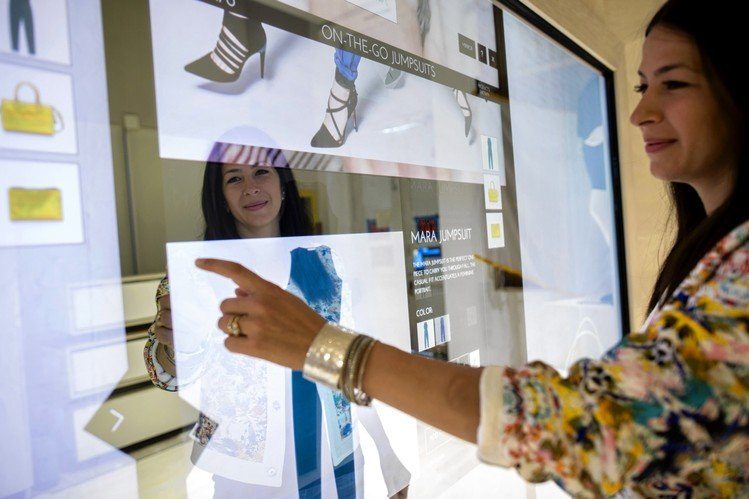Article
Blurred Lines: How Technology Can Give Customers an Unforgettable In‑Store Experience
April 21, 2016

It’s hard to deny digital’s influence on the retail customer experience. According to Deloitte research, digital channels, apps, and tools influenced 64% of all in-store sales in 2015. That influence is expected to increase significantly over the next six years, driving the ongoing convergence between the e-Commerce and brick-and-mortar worlds.
The breakdown between digital and physical channels—and consumers’ increased savviness— is making omnichannel marketing a business imperative for brands of all sizes and product categories.
The retailers that win will be the ones that create a compelling customer experience that flows seamlessly between their e-Commerce sites and physical stores. As Scott Galloway, Founder and CEO of L2 has said:
“Pure-play retail is going away. E-Commerce retailers will either open stores or go out of business. And retailers need to be excellent at digital or they will go out of business.”
Although retailers understand the importance of omnichannel, it can be challenging for them to figure out exactly how to create more seamless and enjoyable customer experiences. Sometimes, the best place to start is to take cues from your peers.
Here are three tips for providing better experiences across digital and brick-and-mortar stores, driven by examples from retail brands that are leading the charge.
Tip #1: Make Sure Your Technology Serves a Purpose
FOMO makes it easy for brands to implement new technology without considering how it integrates with the rest of their customer experience strategy.
Before you launch a new channel, app, or digital service, consider the role it will play in your store experience; make sure it addresses a specific need or improves the lives of your associates or customers. In-store technology should create what’s called “happy speed bumps”; it should educate and engage shoppers and guide them along the purchase path by helping them discover products and make decisions.
Rebecca Minkoff is one of the few retailers that has successfully integrated technology to surprise and delight customers. Her connected store in New York City has set the standard for what it means to create the Store of the Future—a very hot topic in the retail world.
The store uses interactive technology to create a high-end and hassle-free customer experience. Upon entering, shoppers are faced with a large digital display showing Rebecca Minkoff-branded content. They can interact with the screen to sift through content, order a bottle of water, or even request a glass of champagne!
When shoppers pick out items and enter a fitting room, the lights dim and an interactive screen turns on to show product recommendations. For example, if a shopper is trying on a dress, she will see images of shoes, a purse, jacket, or jewelry that will help her finish the look. If she needs help or wants to try a different size, she can touch a help button on the screen, which triggers an associate’s mobile device.

Sure, this technology is cool, but it serves a higher purpose: it all works together to make the shopping experience seamless, enjoyable, and unforgettable.
Tip #2: Don’t Forget About Your Associates
Store associates are retailers’ most powerful advocates and brand-building tools. They manage day-to-day activities, they keep stores clean and neat, and they are often a brand’s first point of contact with the customer.
Retailers can use technology to keep employees engaged and position them for success. True Religion knows this firsthand; its in-store technology improves the experience for both store associates and customers.
The brand arms associates with a mobile POS so they can easily sift through products and find the item sizes and colors customers are looking for. When shoppers are ready to make a purchase decision, associates can add items to the digital cart, submit delivery and payment information, and complete the transaction.
True Religion is also one of the first brands to add smartwatches to its in-store technology stack. The brand partnered with Aptos and Formula 3 Group to develop an “endless aisle” app for the Apple Watch that provides a comprehensive view of products available online and in stores.

Using the app, associates can sift through product images. When they find the item they’re looking for, they can push it to a large digital display that gives customers a better view. Should a customer decide to purchase a product, an associate can scan a digital barcode and order the item using their mobile device.
Tip #3: Let Your Customers Take Control
In partnership with Nordstrom, Shoes of Prey opened six Design Studio shops where customers can sit at a station and design a customized pair of shoes. When they’re finished with their creations, shoppers can either place their orders or save them to their account and purchase later.
Not every retail business can offer extensive customization options like Shoes of Prey, but brands can learn from how the company uses technology to empower customers to design their own in-store experience.
—
There are many ways brands can use technology to combine digital and in-store experiences. Whether your goal is to engage shoppers, empower employees, or streamline operations, you should always keep your customers in mind. After all, if they don’t have a fantastic interaction with your brand, you will leave potential sales and customer loyalty on the table.
This article was written by Shauntle Barley from Business2Community and was legally licensed through the NewsCred publisher network.![]()
The State of Brand Loyalty in the U.S. in 2023
Related



